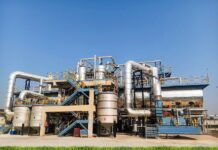
Shibuya Hoppmann, a global leader in aseptic filling and automation systems, highlights its dry aseptic and ESL filling solutions, designed to meet the diverse production needs of beverage and dairy manufacturers. These proven platforms combine robust microbial control, high-speed performance, and hygienic system design to deliver safe, efficient, and sustainable packaging for sensitive, shelf-stable, and high-viscosity products.
The Dry Aseptic Filling Decontamination System utilizes dry hydrogen peroxide vapor to sterilize both the internal and external surfaces of PET or HDPE bottles. This advanced aseptic filling system achieves <0.5 ppm residuals, meets FDA standards, and supports clean-label formulations for low-acid beverages like teas, dairy, flavored waters, and nutraceutical drinks.
Capable of handling bottles from 60-3,800 ml at speeds up to 1,200 bpm (72,000 bph), the system features net weight filling, 100% servo-controlled capping, and rapid sterile changeovers to ensure operational continuity without breaking sterility. Its clean aseptic design free of dead legs and condensation enhances CIP/SIP performance and reduces downtime.
Dynamic sealing of rotating and stationary parts prevents sterile zone breaches, enhancing hygienic reliability during high-speed operation. The system also delivers environmental and cost advantages, including lower chemical use, high overall equipment efficiency (OEE), and reduced CO₂ emissions, contributing to greater sustainability and a lower total cost of ownership (TCO). Additionally, the aseptic system supports ambient-temperature transport and storage, which extends shelf life and reduces cold-chain logistics requirements, significantly lowering operational costs and carbon footprint.
For dairy, plant-based, and extended shelf-life (ESL) applications, Shibuya’s ESL & dairy filling system provides unmatched flexibility. The platform supports both hydrogen peroxide and peracetic acid (PAA) bottle decontamination and accommodates a wide range of low- and high-acid products including UHT milk, drinkable yogurts, smoothies, oat beverages, and protein shakes.
A unique multi-viscosity filling valve supports up to 1000 cps and enables seamless transitions between product types without thermal degradation. The system handles particulates up to 10mm and enables over 200 hours of continuous aseptic operation without CIP/SIP interruption, ideal for high-mix, high-efficiency dairy production.
Both systems offer 100% data collection and real-time monitoring of filling and capping operations, providing traceability and in-line quality assurance. To maintain sterile integrity, they use advanced isolation and sealing technologies tailored to high-speed environments. Their streamlined architecture supports tool-less changeovers and sanitary design principles that reduce cleaning time and simplify maintenance, ensuring consistent uptime even in demanding, multi-SKU production settings.
With a proven record of zero spoilage in over 20 billion bottles filled and over 30 years of aseptic filling system installations, Shibuya Hoppmann’s aseptic technologies deliver reliable performance across sensitive beverage and dairy categories. These scalable solutions align with growing industry demands for sustainable packaging, product safety, and production versatility backed by the precision of Japanese engineering and local U.S. support.
Shibuya Hoppmann is a recognized leader in automation systems and aseptic filling equipment, offering integrated solutions across beverage, dairy, personal care, household, pharmaceutical, and food markets.
IndiFoodBev — authentic, impactful and influential
An English-language food and beverage processing and packaging industry B2B platform in print and web, IndiFoodBev is in its third year of publication. It is said that the Indian food and beverage industries represent approximately US$ 900 billion in revenues which implies more than 20% of the country’s GDP. Eliminating the wastage on the farmside can help to deliver more protein to a higher number of the population apart from generating sizable exports. The savings in soil, seeds, water, fertilizer, energy and ultimately food and nutrition could be the most immense contribution that country is poised to make to the moderation of climate change.
To improve your marketing and grow sales to the food and beverage processing and packaging industry, talk to us. Our research and consulting company IppStar [www.ippstar.org] can assess your potential and addressable markets in light of the competition. We can discuss marketing, communication, and sales strategies for market entry and growth.
Suppliers and service providers with a strategy and budget for targeted marketing can discuss using our hybrid print, web, video, and social media channels to create brand recognition linked to market relevance. Our technical writers are ready to meet you and your customers for content.
The second largest producer of fruit and vegetables in the world is continuously expanding processing capacities and delivery systems with appropriate innovative technologies. We cover product and consumer trends, nutrition, processing, research, equipment and packaging from farm to thali. Get our 2025 media kit and recalibrate your role in this dynamic market. Enhance your visibility and relevance to existing markets and turn potential customers into conversations. Ask for a sample copy of our bi-monthly in print or our weekly IndiFoodBev eZine each Wednesday.
For editorial info@ippgroup.in — for advertisement ads1@ippgroup.in and for subscriptions subscription@ippgroup.in
Naresh Khanna – 10 February 2025
Subscribe Now










